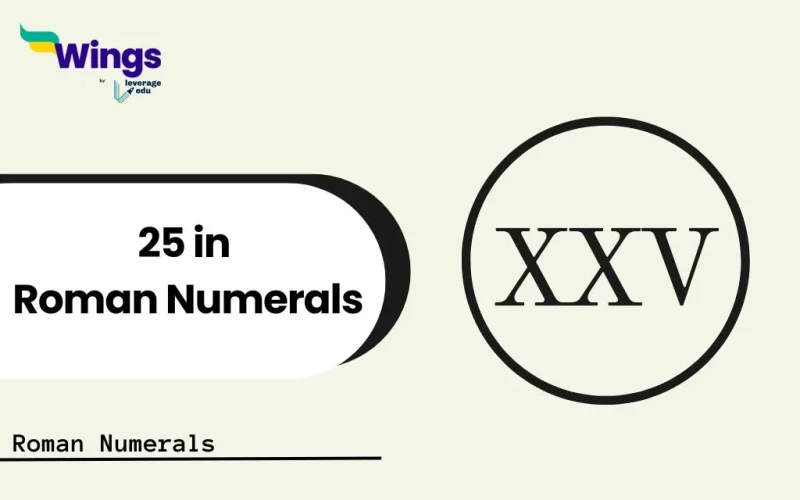Writing 25 in Roman numerals is straightforward once you know the basics. Roman numerals use combinations of letters to represent numbers. For 25, the symbols are XXV, where XX represents 20 (two tens) and V represents 5. Unlike numbers like 40 (XL) or 9 (IX), 25 is expressed by directly combining the symbols without using subtraction. Learning Roman numerals enriches your understanding of ancient numbering systems and can be fun for students. Let us start the learning process by understanding different aspects of how to write 25 in Roman numerals.
Contents
How to Write 25 in Roman Numerals?
To write 25 in Roman numerals, you use the letters XXV. This is a combination of XX, which represents 20, and V, which represents 5. There’s no need for any additional calculations or complex combinations for this number.
| Number | Roman Numeral |
| 25 | XXV |
How to Convert XXV to Number
To convert XXV from Roman numerals to a number, you simply need to know the values of the Roman numerals that make up XXV. In this case, X represents 10, and V represents 5. Adding these together (10 + 10 + 5) gives you 25. Roman numerals are made up of seven symbols (I, V, X, L, C, D, M), and each has a fixed value.
| To convert XXV from Roman numerals to a number, follow these steps: Break it down into individual Roman numeral symbols: X = 10 X = 10 V = 5 Add the values together: 10+10+5=25 So, XXV equals 25 in standard numbers. |
Check out a list of Roman numbers from 21 to 30 in the following table:
| 21 in Roman Number | 26 in Roman Number |
| 22 in Roman Number | 27 in Roman Number |
| 23 in Roman Number | 28 in Roman Number |
| 24 in Roman Number | 29 in Roman Number |
| 25 in Roman Number | 30 in Roman Number |
Exercise on 25 in Roman Numerals
Let us practice some questions on Roman Numerals here.
Addition and Subtraction
Add/subtract the following numbers and answer in Roman Numerals
- 25 + 25 = ___
- 100 – 25 = ___
- 20 + 25 = ___
- 55 – 25 = ___
Answers:
- 25 + 25 = 50 → L
- 100 – 25 = 75 → LXXV
- 20 + 25 = 45 → XLV
- 55 – 25 = 30 → XXX
Convert to Roman Numerals
Convert the following numbers into Roman numerals:
- 125
- 150
- 50
- 75
Answers:
- 125 → CXXV
- 150 → CL
- 50 → L
- 75 → LXXV
Convert to Numbers
Convert the following Roman numerals to numbers:
- XXX
- LXV
- CCXXV
- CCL
Answers:
- XXX → 30
- LXV → 65
- CCXXV → 225
- CCL → 250
Match the Following
Match the following numbers to Roman numerals:
| Numbers | Roman Numerals |
| (i) 105 | (a) CCL |
| (ii) 205 | (b) LXXV |
| (iii) 75 | (c ) CCV |
| (iv) 250 | (d) CV |
Answers:
(i) 105 → (d) CV
(ii) 205 → (c) CCV
(iii) 75 → (b) LXXV
(iv) 250 → (a) CCL
Check out other Roman Numbers here:
| 11 in Roman Numerals | 31 in Roman Numerals |
| 12 in Roman Numerals | 32 in Roman Numerals |
| 13 in Roman Numerals | 33 in Roman Numerals |
| 14 in Roman Numerals | 34 in Roman Numerals |
| 15 in Roman Numerals | 35 in Roman Numerals |
| 16 in Roman Numerals | 36 in Roman Numerals |
| 17 in Roman Numerals | 37 in Roman Numerals |
| 18 in Roman Numerals | 38 in Roman Numerals |
| 19 in Roman Numerals | 39 in Roman Numerals |
| 20 in Roman Numerals | 40 in Roman Numerals |
FAQs
Ans: XXV = 25
Ans: 25 is represented as XXV, where X equals 10 (10 + 10 = 20) and V equals 5 (20 + 5 = 25).
Ans: X = 10
Ans: 5 = V
Ans: 20 = XX
Ans: The Roman numeral system originated in ancient Rome and was developed for counting, trade, and record-keeping.
Ans: The basic symbols are:
I = 1
V = 5
X = 10
L = 50
C = 100
D = 500
M = 1,000
Ans: Romans used tools like abacuses or manually combined symbols to perform addition and subtraction. Multiplication and division were more complex and often avoided.
Ans: The Roman numeral system evolved primarily for counting tangible items, so zero was not considered necessary in their daily calculations.
Ans: Roman numerals are still used in modern contexts, such as numbering book chapters, naming events, and marking clock faces.
Ans: Its simplicity in small numbers and distinct visual representation make it useful for labelling and decorative purposes.
Ans: Roman numerals lack a zero, making it less efficient for complex calculations. Representing large numbers can also be cumbersome.
Ans: Roman numerals helped standardise numeric representation in Europe before the introduction of Arabic numerals.
Ans: They are often used in clocks, monuments, film titles, and royal or papal names (e.g., Queen Elizabeth II).
Ans: Teaching Roman numerals helps students understand historical numbering systems, cultural heritage, and their applications in modern contexts.
For more blogs on school education, follow Leverage Edu now.
 One app for all your study abroad needs
One app for all your study abroad needs














